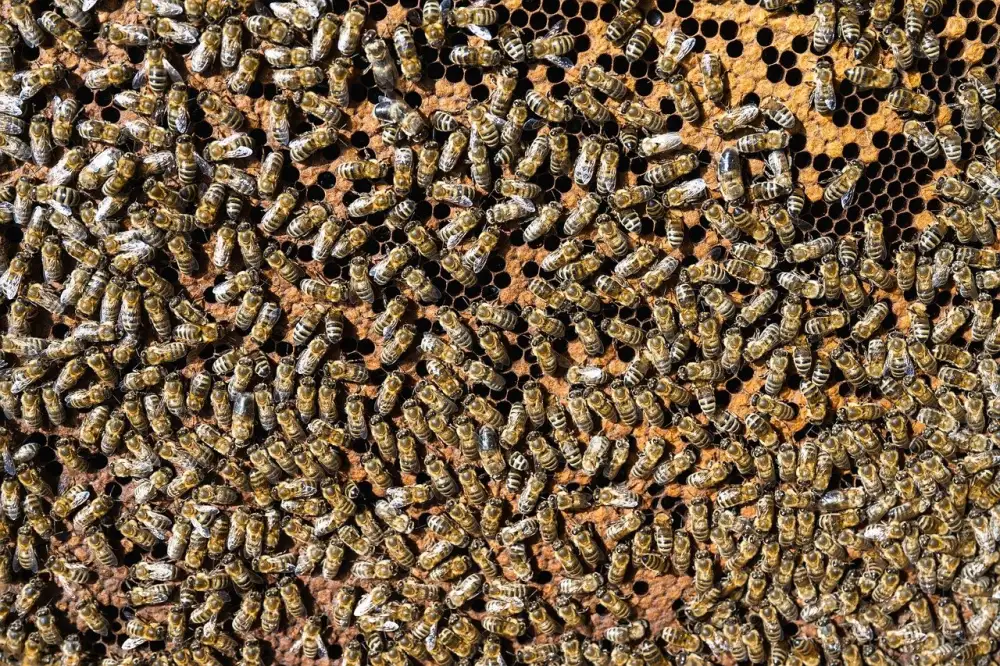Honeycomb: Nature's Sweet Hexagonal Creation Unveiled

Honeycomb, a marvel of nature's engineering, is a hexagonal structure created by bees using beeswax. This intricate network of cells serves as storage for honey and larvae in the beehive. The unique shape of honeycomb allows bees to maximize storage space while minimizing the amount of wax used in its construction. Honeycomb not only provides a secure environment for the hive but also plays a crucial role in the lifecycle of bees and the production of honey.
Formation of Honeycomb by Bees
Honeycomb is a marvel of nature created by the diligent work of honeybees. Worker bees secrete beeswax from special glands on their abdomen, which they chew and mold into the hexagonal cells that make up the honeycomb structure. These cells serve as storage units for honey, pollen, and developing bee larvae. The precise hexagonal shape allows for efficient use of space and maximizes storage capacity within the hive. Bees use their body heat to soften the wax and shape it into perfect hexagons, showcasing their remarkable instinctual behavior and cooperative efforts in building this intricate masterpiece.
Composition and Nutritional Value of Honeycomb
Honeycomb is a natural wonder composed of beeswax hexagonal cells filled with honey. It contains various vitamins, minerals, and antioxidants that contribute to its nutritional value. Honeycomb is rich in carbohydrates, primarily in the form of fructose and glucose, providing a quick source of energy. Additionally, it contains small amounts of proteins, enzymes, and traces of pollen from the flowers visited by bees. The consumption of honeycomb can provide health benefits due to its antioxidant properties and potential anti-inflammatory effects.
Culinary Uses of Honeycomb
Honeycomb is not only a natural wonder but also a versatile ingredient in the culinary world. Its sweet, waxy hexagonal cells can be enjoyed in various ways. One popular way to savor honeycomb is by simply drizzling it over cheese or pairing it with charcuterie boards for a delightful mix of flavors and textures. It can also be chopped and used as a topping for desserts like ice cream or yogurt, adding a unique crunch and sweetness. Additionally, honeycomb can be incorporated into salad dressings or marinades to infuse dishes with a hint of natural sweetness. Its distinct taste and texture make honeycomb a sought-after ingredient in both sweet and savory recipes, elevating dishes with its unique flavor profile.
Health Benefits of Consuming Honeycomb
Honeycomb is not only a delicious treat but also offers numerous health benefits when consumed. It is rich in antioxidants, enzymes, vitamins, and minerals that can boost the immune system and promote overall well-being. The enzymes in honeycomb aid in digestion and can help alleviate digestive issues. Additionally, the antibacterial properties of honeycomb can support wound healing and soothe sore throats. Regular consumption of honeycomb may also help reduce inflammation and improve heart health due to its anti-inflammatory and cholesterol-lowering effects.
Sustainability and Environmental Impact of Honeycomb Production
Honeycomb production is a sustainable practice as it supports bee populations crucial for pollination. Bees play a vital role in maintaining biodiversity and ecosystem health. However, factors like habitat loss, pesticide use, and climate change pose threats to bee populations and honeycomb production. To mitigate these risks, sustainable beekeeping practices such as organic farming methods and creating bee-friendly habitats are being encouraged. Supporting local beekeepers who prioritize the well-being of bees can help ensure the sustainability of honeycomb production for future generations.
In conclusion, honeycomb is a remarkable creation of nature that not only serves as a home for bees but also offers a myriad of culinary and health benefits. Its unique hexagonal structure and natural sweetness make it a versatile ingredient in various dishes and desserts. From adding texture to salads and cheese platters to being used as a natural sweetener or even enjoyed on its own, honeycomb can elevate the taste experience. Moreover, its nutritional value and potential health benefits further highlight its significance in the culinary world. By appreciating the craftsmanship of bees and understanding the sustainable production of honeycomb, we can truly savor and respect this exquisite gift from nature.
Published: 24. 04. 2024
Category: Food



